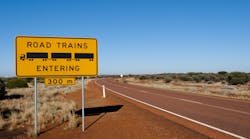When the North Dakota legislature meets in January, lawmakers will consider whether or not to go ahead with a “road train” pilot program in that state and the likelihood of buy-in from neighboring “open-space,” low-population areas such as South Dakota and Minnesota, and perhaps even the Canadian province of Manitoba.
The proposal, sought by many in North Dakota’s agricultural and timber interests, is being championed by Chairman of the Senate Agriculture Committee Larry Luick, who runs a farm one mile from South Dakota.
"In South Dakota, they can pull a full two doubles, and it has been really frustrating to the drivers from South Dakota that come to North Dakota because we can't do that in North Dakota,” Luick said. “If they want to drop grain in North Dakota, they have to unhook, drop or go and dump the first trailer. Then, they have to come back and unhook, hook onto another trailer and go into North Dakota and dump the second trailer. We can do a lot better.”
"I believe that with the right guidance we can put together a program that's going to be safe, and much more efficient in moving freight than what we are doing today," added Luick, who also holds a commercial driver’s license (CDL).
Luick was hoping to establish the parameters of a pilot program last summer and a road train test program this fall but the pandemic set back any possible timetable. The North Dakota legislature only meets every other year which also curbed any movement. "It isn't going to happen until probably next spring or summer," he noted.
How long would be these proposed road trains be?
"On different roads, it would be different sizes," explained Luick. "So, if we are hauling from Western North Dakota to Shakopee, Minn., we could get by with either three or four full length trailers on the interstate to do that. However, if we can’t do that, [we could get by with] up to three full length trailers on state roads that are four lanes and maybe two full length trailers on two-lane highways. It gets back to what I requested of the state [Department of Transportation] — that they put this into their wheelhouse and figure it out. What's the safety aspect of this? You want to be able to pass this vehicle just as comfortably as you would a regular semi. And you certainly don't want to get behind one on a two-lane highway in case it's going a little slower than regular traffic. That's hazardous as well."
While Luick may have luck getting this through the state legislature — and he hopes that his Congressional delegation will support it — there seems to be little interest for larger trucks on a nationwide level.
One of the main reasons is a lack of data. While doubles and triples have excellent safety records, in states where multiple trailers are allowed, this may be the result of cherry picking the environment. For example, long combination vehicles, or LCVs, are subject to weather restrictions. They are often not permitted on slippery road surfaces, high wind areas or during other adverse driving conditions.
"One of the issues is that these vehicles have a good safety record, but the problem is they only operate in captive environments,” explained Tom Bray, senior transportation industry advisor for JJ Keller & Associates. “They're only allowed on interstate roadways in certain states and in certain areas. There was a study done a few years ago, and while they do have an excellent safety record, [the U.S.] DOT doesn't believe there's a nationally representative estimate based on what they see in the safety data so far. To me, the big thing is these vehicles need to get more miles on them in more areas to be able to prove or disprove their safety value and safety performance."
Politically, there's a lot of pushback against larger trucks, Bray added.
"There's the Coalition Against Bigger Trucks (CABT). OOIDA [Owner-Operator Independent Drivers Association] has come out against it, and the railroads,” he said. Railroad stakeholders are a major contributor to CABT.
“Congress just doesn't have an appetite for larger vehicles,” Bray continued. “Right now, a standard double set is twin 28s. There's been a push to get them up to 33 ft., and that hasn't been able to go anywhere. Just adding 5 ft. to existing double sets hasn't gone anywhere, and that's been with a trucking-friendly Congress in the past, so there just doesn't seem to be a big appetite for it."
In May, 82 members of Congress signed a letter rejecting any effort to increase the size of trucks.
Both Bray and Luick dismiss the idea of the Australian road train model for U.S. roads. These vehicles, operating in the sparse Outback can haul over 200 tons and be as long as 175 ft. on private roads. They are not allowed in cities.
LCVs in the U.S. are possible from a mechanical point of view. Tractors can handle them, the drivetrains can handle them, and drivers can be specially trained to handle them. But there's also the issue of driver acceptance, noted Bray.
"Under the current pay model, as a driver I would have no motivation to pull three trailer,” Bray said. “I used to pull regular doubles years ago, and it's a lot of work getting the strings set up and getting ready to go down the road for no extra money. There's just not a big driver appetite for it, although some drivers love it. State-to-state issues are going to come into play again, too, because you're going to be able to form up this six-truck string to go this far, or this three-trailer string or whatever to go this far, but then you're going to hit this certain state line and you're going to have to stop, break it all down, add power units, and that poor driver is going to have to go from the marshaling yard to wherever with all those trailers. The other people that don't have a whole bunch of appetite for this are the insurance carriers."
When asked about insurance issues, an official of the Insurance Information Institute said that estimating the insurance risk of road trains "is beyond our area of expertise."
In an email, a spokesperson for the Coalition Against Bigger Trucks stated: "The Coalition Against Bigger Trucks (CABT) opposes a North Dakota draft resolution calling on Congress to allow a pilot project for 'truck road trains' on highways in North Dakota and surrounding states. The idea of even longer and heavier trucks on North Dakota roads should scare any resident … pilot projects turn motorists into guinea pigs and roads into test tracks. These proposed, untested 'truck road trains' will be traveling next to motorists on their way to school, to work and for recreation and will be damaging already failing roads and bridges. Why would any state legislature want to subject their residents to the dangers of these massive 'truck road trains'?"




